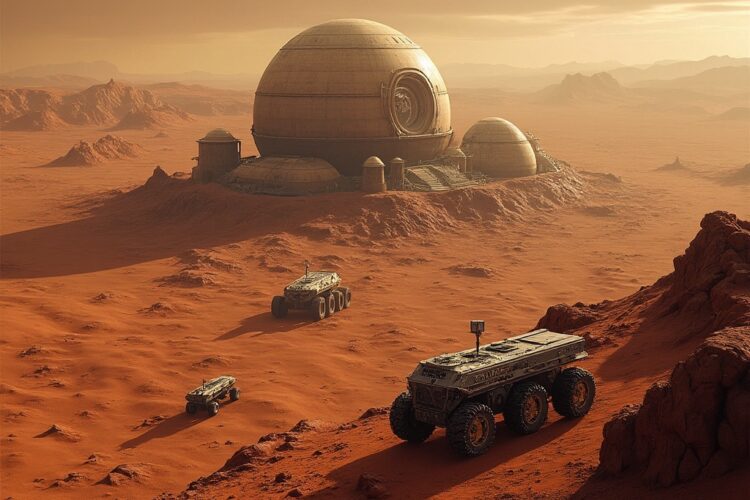Terraforming Mars is a complex and challenging process that involves introducing greenhouse gases, creating a magnetic field, producing liquid water, and increasing temperature. While it has potential benefits, such as expanding human presence in the solar system and providing a backup plan for Earth, there are also significant challenges, ethical concerns, and unknown consequences. Ultimately, the decision to terraform Mars will depend on various factors, including scientific feasibility, technological readiness, and societal priorities.
Long Version
Mars, also known as the Red Planet, has always fascinated scientists and space enthusiasts around the world. One of the most exciting prospects about Mars is the possibility of terraforming it, which is the process of transforming a planet or other celestial body to become more Earth-like in terms of atmospheric and surface conditions, in order to make it habitable for human beings. The concept of terraforming Mars has been explored in science fiction for decades, but is it actually feasible in reality? In this article, we will examine the feasibility of terraforming Mars, including the scientific and technological challenges involved, as well as the potential benefits and drawbacks of such an ambitious project.
The current state of Mars:
Before we delve into the possibility of terraforming Mars, let’s first take a look at the current state of the planet. Mars is a cold, arid planet with a thin atmosphere consisting mainly of carbon dioxide. Its average surface temperature is about -80°F (-62°C), which is far too cold for human beings to survive without protection. Mars also lacks a protective magnetic field, which means that it is exposed to harmful solar radiation that can damage or kill any living organisms on the surface.
The feasibility of terraforming Mars:
In order to terraform Mars, several major changes would need to be made to its atmospheric and surface conditions. These include:
- Increasing atmospheric pressure: Mars’ atmosphere is currently too thin to support life as we know it. In order to increase atmospheric pressure, large amounts of greenhouse gases would need to be introduced into the atmosphere, such as carbon dioxide or methane. This would cause the planet’s temperature to rise and create a greenhouse effect, which would help to trap heat and increase atmospheric pressure.
- Creating a magnetic field: A magnetic field is essential for protecting any living organisms on the surface of a planet from harmful solar radiation. While it is not yet clear how to create an artificial magnetic field on Mars, one possible solution is to place a large magnetic shield at the L1 Lagrange point between Mars and the sun. This shield would need to be continuously powered and maintained to provide adequate protection.
- Producing liquid water: Liquid water is essential for life as we know it. While Mars is known to have frozen water at its poles and underground, it would be necessary to melt this water and distribute it across the planet in order to create a habitable environment.
- Increasing temperature: Mars’ average surface temperature is far too cold for human beings to survive without protection. Increasing atmospheric pressure and producing a greenhouse effect would help to raise the planet’s temperature, but other methods may also be necessary, such as reflecting sunlight onto the planet’s surface.
The challenges of terraforming Mars:
Terraforming Mars would be an extremely complex and challenging process, with several major obstacles to overcome. These include:
- Cost: Terraforming Mars would require an enormous investment of resources and funding, likely on the order of trillions of dollars over several decades or even centuries.
- Time: Even with the most advanced technology available, terraforming Mars would likely take centuries or even millennia to complete. This means that any benefits from the project would not be realized for generations, which could make it difficult to justify the cost and effort.
- Ethics: There is a philosophical debate over whether or not it is ethical to alter the natural environment of another planet, especially if that planet may already have its own unique forms of life.
- Technical challenges: There are several technical challenges that need to be overcome in order to terraform Mars, such as developing methods to introduce greenhouse gases into the atmosphere, creating a magnetic field, and producing large amounts of liquid water.
The potential benefits and drawbacks of terraforming Mars:
If successful, terraforming Mars could have several potential benefits. It would provide a new frontier for human exploration and settlement, potentially allowing us to establish a second home for humanity and expand our presence in the solar system. It could also offer new opportunities for scientific research and discovery, such as studying the effects of long-term space habitation on human health and developing new technologies for space travel and resource utilization. In addition, terraforming Mars could potentially serve as a backup plan for Earth in case of a catastrophic event, such as an asteroid impact or a major climate change event.
However, there are also several potential drawbacks to terraforming Mars. For one, it could potentially disrupt any existing forms of life on the planet, even if they are only microbial in nature. This raises ethical concerns about the potential impact of terraforming on the Martian ecosystem. Additionally, the long-term effects of terraforming on Mars are still largely unknown, and there may be unintended consequences that we cannot anticipate or control. Finally, there is also the question of whether the resources and funding required for terraforming Mars could be better used for other pressing issues, such as addressing climate change and inequality here on Earth.
Conclusion:
In summary, while the idea of terraforming Mars is intriguing and exciting, it is also an extremely complex and challenging undertaking that would require significant investment of resources, time, and effort. The scientific and technological challenges involved are significant, and there are also ethical and philosophical questions to consider about the impact of terraforming on the Martian environment. Ultimately, the decision of whether or not to pursue terraforming Mars will depend on a variety of factors, including scientific feasibility, technological readiness, ethical considerations, and societal priorities.
Words Worth Noting
terraforming, Mars, atmosphere, greenhouse gases, magnetic field, radiation, water, temperature, cost, time, ethics, technical challenges, exploration, settlement, scientific research, space habitation, resource utilization, backup plan, catastrophic event, microbial life, unintended consequences, funding, climate change, inequality, societal priorities, philosophical debate, space travel, human health, new technologies
Hashtags For Social Media
#terraforming #Mars #atmosphere #greenhousegases #magneticfield #radiation #water #temperature #cost #time #ethics #technicalchallenges #exploration #settlement #scientificresearch #spacehabitation #resourceutilization #backupplan #catastrophicevent #microbiallife #unintendedconsequences #funding #climatechange #inequality #societalpriorities #philosophicaldebate #spacetravel #humanhealth #newtechnologies






